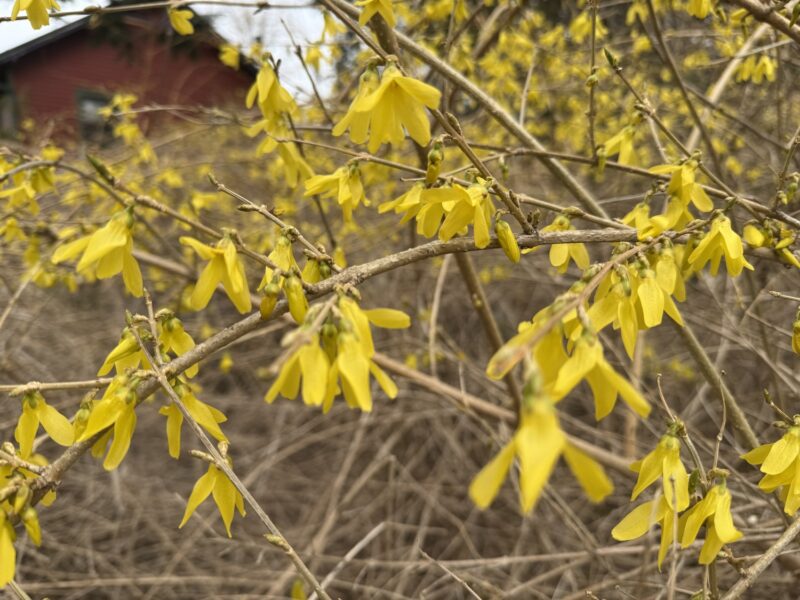

We often forget that so many things turn plants on and off. There’s air temperature and soil temperature. Hours of light and hours of dark. Daytime temperature and nighttime temperature. Number of days below or above a certain temperature. Setting fruit and setting buds.
More than three decades ago a mandate was issued from the federal government down to the states requiring education and training of those employed professionally in the areas of agriculture and horticulture. The goal? To begin using the least damaging and least harmful methods of controlling pests. This included insects, diseases and weeds. It began a movement toward what we called Integrated Pest Management, or IPM.
We see the results today in the fact that timing has become critical in the use of pesticides. We use less of them, we’re more careful when we use them and we have some incredible tools that allow us to be very, very precise in the use of both organic and chemical controls. The science of phenology has become critical in the entire process.
Phenology is defined as the study of recurring biological phenomena and its relationship to weather — biological phenomena such as animal migration, the flowering of plants, crop development and the seasonal appearance of insects and diseases. Plant phenology can therefore be explained as the study of plant development as it relates to weather.
I try to keep records on many of the 1,080 plant varieties in my gardens, including when perennials emerge from the ground and when my perennials, trees and shrubs flower and when certain insects emerge. It’s as simple as studying when things happen and when I can expect them to happen. For the most part, it’s based on plant phenology. This year, though, there were a few surprises and some confusion.
I kept records for years on when the forsythia on the Long Island Expressway flowered. For many years I did the trek into Nassau County on a daily and then a weekly basis. I thought the forsythia could serve as a good indicator about the rest of the plant world. But now I have some doubts about my theory.
This year, the forsythia in my upstate property was at 30 percent bloom in mid-April. My records showed that this is about 10 days earlier than in 2022. But I would have thought that with this having been the coldest winter in a decade that everything would be happening slower. The logic being that colder soil and air temperatures would slow things down. But in the case of the forsythia, it didn’t. One clue may be that while the temperature can be variable, the hours of daylight (and darkness), while changing daily, are not variable from year to year.
However, when I looked at other plants that emerge from bulbs or crowns like Cyclamen coum and some early primulas, they were running about a week late. That made sense to me since the colder soil later into spring would slow them down. But there were contrarians like the fritillaries, which emerged right on time, as did the snowdrops that flowered with light snow on the ground. Mother Nature is usually reliable but not always dependable, and I remain mystified.
One theory that plant scientists have been studying for the past 40 years is that a phenological development, such as flowering, be used as an indicator of when a specific species of insect is active, so that strategies to control the insect pest can be precisely timed. This work is very similar to the work involving grower degree days (GDDs) that orchards, farms, nurseries, tree companies and lawn care businesses are now using to predict the emergence of certain insects. The GDD method has been extremely successful and has resulted in the substantial reduction in the amount and number of pesticide applications on many crops. It may even be in use in your backyard if you are subscribing to a tree service that is properly monitoring your property using GDDs and visual observations or a lawn service that tracks GDDs to predict disease, insect and weed appearance. But GDDs are not always effective and additional tools are needed.
When do different insects become active? Obviously, not during the winter when the temperatures are low. As the season progresses and spring begins, the buds of trees and shrubs swell and open into flowers and new leaves. The earliest of spring flowers pop their heads above the ground even if it’s covered with snow. Plants respond to seasonal changes, increasing daylight hours and rising air and soil temperatures. Insects respond similarly. Both are moving in accordance with their biological clocks (which will probably be running a bit late this year). These clocks tick a little differently each year depending on the day-to-day weather conditions and seasonal patterns.
It’s not very easy to determine if a particular insect is active. Insects are small, mobile and often difficult to observe, especially early in the season when the first few to survive the winter are either hatching or emerging. Plants, on the other hand, are much easier to watch and analyze. They are in the same location year after year and put on a flowery show that is seldom missed. The question that scientists have asked in the past, and are asking again, is whether plant phenology can tell us something about insect activity. Can certain plants and insects be responding to the same “rhythm”?
A scientist in Michigan researched this theory by monitoring the phenology of 24 different insect pests and also the phenology of 47 plant species three times a week over a period of five years. He collected dates for when plants first bloomed and also when they were in full bloom. In his study spring weather varied, cool in some years and warm in others. Although the seasons varied and exact dates varied, the response as to when specific plants bloomed, and insects appeared remained in the same order.
Why is this important? In the past, timing to control pests was based solely on the calendar method, or the same dates year to year despite seasonal variations. Remember the common wisdom that you should apply a crabgrass preemergent when the forsythia blooms? With this new information and the use of GDDs, it’s now possible to use the least-toxic pesticide, in many cases an organic or biological one, and make an application on the day or within hours of when the insect or weed population emerges or when it might be at its most vulnerable stage.
Now the big question, can you use this phenological approach to controlling insects, diseases and weeds in your home garden, and can we use the same method in community parks and gardens? The answer is yes. Continuing research is supplying more and more information about coinciding plant and insect growth and activities, but you have to remember that variables exist that affect the results. Insect populations and plant varieties have genetic differences in different localities.
Growing conditions can be very different for particular spots in one small area (as in micro climates), therefore the system, as yet, is not foolproof and can only be used as a guide — a rough guide at that. You can get more information on current local growing degree days here, ccesuffolk.org/agriculture/growing-degree-days-gdd. And if you garden elsewhere, there are GDD resources all over the country now. Keep growing.
Garden Notes
Speaking of forsythia, when you drive around and see these harbingers of spring you’ll notice that while they are all yellow, the hue of yellow is dependent on the variety of forsythia. Modern varieties tend to be much more vibrant while the older ones are a bit dull. Something to consider if you’re in the market for a new forsythia planting or hedge. And once they finish flowering it’s time to prune and shape them. Do this later in the summer and you’ll have no flowers at all next year since you will have pruned off all the flower buds for next year’s blooms.
Lily bulbs can be rather expensive. Once the bulbs are planted, certain animals, mostly rodents like squirrels and voles, have special radar to find them and make a meal of them. You can protect these bulbs by dipping them in a product called Bobbex-R. There are several formulations of Bobbex; buy the “R” which indicates the repellent type. Spray it on the bulbs if you get the spray bottle, or dip the bulbs if you buy the gallon jug (about $32). Allow the material to fully dry then plant the bulbs. Also works on fall-planted bulbs. Don’t rush to get your indoor-started plants outdoors.
Our last frost-free date is around April 24 but any plant or seedling started indoors needs initial protection from the cold and the wind. Use a row cover material to cover them at night or even better put them in the cold frame. Even covering them with a sheet of newspaper is better than nothing. Keep an eye on trees, shrubs and perennials planted last fall. The dry fall and cold winter may leave lingering damage. If you suspect that a plant has been damaged don’t give it fertilizer. Give it some time to recover, and once it shows clear signs of healthy new growth it can be fed.
Begin feeding roses once they have been prunes of winter dieback and the new buds are breaking. Light feeding with an organic rose or flowering plant fertilizer will do the trick.
Monitor emerging lilium foliage for the red lily beetle. Pick them off and drop into soapy water or spray with a contact organic pesticide. If you allow them to lay eggs they will be an issue all summer.
 More Posts from Andrew Messinger
More Posts from Andrew Messinger